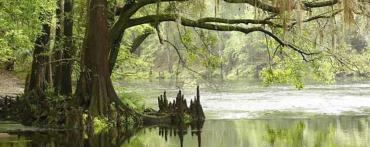
Let's hope lawmakers whose heads are turned by the Everglades Foundation's "buy the land" bus tour and petition drive also saw Thursday's South Florida Water Management District news.
It dispels virtually every claim the Foundation is making.
Without science to back up their claims, the Foundation folks are traveling across Florida crying that the state needs more land south of Lake Okeechobee to help "Save the Everglades." Not even close. The Water Management District just released updated facts, they have the science to back them up, and it's about the best environmental news we've heard in some time. (See the comparison maps at the bottom of this page.)
Read "Florida Achieving Everglades Water Quality Goals" by clicking this link. Not only are the Everglades healthy, they are remarkably so:
Tests show at least 90 percent of the Everglades, top to bottom, now meets ultra-clean water quality standards for levels of phosphorus of 10 parts per billion (ppb) or less as required by a federal consent decree and established under state law.
Not only that, but 100 percent of Everglades National Park is below 8 ppb. Actually, 86 percent of the total Everglades is at 8 ppb.
I'm just pleading for a little perspective here. The Environmental Protection Agency (EPA) reports more than one-third of the nation's lakes and rivers, except at their headwaters, registers a phosphorus level above 25 ppb.
James Moran, SFWMD Governing Board member, is justifiably proud of the Everglades water data released Thursday. "The water quality targets needed for America's Everglades to thrive are being met thanks to our dedication and use of sound science over the past two decades," Moran said. "With the work already under way through Gov. Rick Scott's Restoration Strategies, we will restore water quality in the Everglades."
No matter what you hear from the alarmists on the bus, progress on Everglades restoration is undeniable:
- Before the Florida Legislature passed the Everglades Forever Act in 1994, water flowing south out of the sprawling Everglades Agricultural Area (EAA) contained an average of 173 parts per billion (ppb) of phosphorus.
- For the past five years, phosphorus levels in Everglades-bound water have averaged 20 parts per billion after being filtered through the District's network of constructed treatment wetlands, known as Stormwater Treatment Areas (STAs).
And now it's even cleaner. Much cleaner. I know the Everglades Foundation people don't want to admit it, but over the 20-year history of the Best Management Practices (BMP) program, phosphorus levels in water leaving the EAA dropped by an annual average of 55 percent compared to initial conditions -- more than twice the improvement required under the Everglades Forever Act.
The BMP program has prevented approximately 3,055 metric tons of phosphorus from entering the Everglades.
But I also realize clean water and a restored Everglades has little to do with the Foundation's motives for their lavish, con-job-of-a-pre-election bus tour. Nor is it about saving the Treasure Coast folks from damaging Lake Okeechobee discharges.
This is all about buying land, taking land out of agriculture production.
“Buying the land” will NOT allow the U.S. Army Corps of Engineers to send more water south. Didn't we see in 2013 and again from late January to November 2016 that Everglades National Park won't take lake water when the land is already so wet? Neither will the water conservation areas (WCAs). They are and have been above their federal flood regulation schedules all year.
As engineers repeat and repeat, storage to the south only marginally helps the Everglades and WCAs when they can't take any more water. Southern water storage never was intended to reduce coastal estuary discharges. The solution to deal with the large volume of water coming from the North and from local basins draining into the rivers was determined to be north, east, west regional storage and deep well sites.
In their NowOrNever petition the Foundation folks claim, “Especially considering the recent devastation to the coastal estuaries and ongoing massive seagrass die-off in Everglades National Park, planning for EAA projects must be expedited and be given top priority over planning for other new Everglades restoration projects.”
Just another part of their campaign of misinformation.
Click on the attachment below, the U.S. Army Corps of Engineers' Fact Sheet on CEPP. You will see the planning, engineering and Chief’s Report have been completed, and both the U.S. House and Senate have approved CEPP as part of the current Water Resources Advisory Act.
What I want you to see in the Corps document is that CEPP already contains the EAA storage reservoir. After Restoration Strategies is built, and it's proved that CEPP can move more CLEAN water south -- we're talking 2021 -- the integrated delivery system calls for looking at the next increment of storage, if needed, south of the lake -- same as it says in the University of Florida water study.
The A-1 and A-2 reservoirs have already been designed with a built-in footprint that could accommodate holding water 12 feet deep if there's the need and the funds to build that much storage -- with NO additional land acquisition costs.
Florida lawmakers, please stay the course, keep the federal government focused on CEPP and let the Foundation's bus leave without you.
Thanks, SFWMD, for the good news: The Everglades isn't dying, it's thriving. Every water body in America should have to show such progress.

These maps compare phosphorus concentrations in the Water Conservation Areas before water quality improvement efforts began and over the last five years. Green dots represent sites with average concentrations 10 parts per billion or less.
Reach Nancy Smith at nsmith@sunshinestatenews.com or at 228-282-2423. Twitter: @NancyLBSmith


